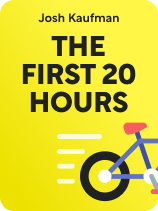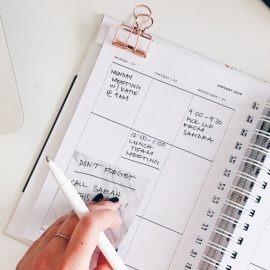

This article is an excerpt from the Shortform book guide to "The First 20 Hours" by Josh Kaufman. Shortform has the world's best summaries and analyses of books you should be reading.
Like this article? Sign up for a free trial here.
When practicing, which is more important—quality or quantity? When should you sleep in relation to your practice time? How much practice should you fit into one day?
In The First 20 Hours, skill acquisition expert Josh Kaufman outlines a step-by-step process for mastering the basics of any new skill with only 20 hours of practice. He provides several tips designed to help you get the most out of those 20 hours.
Keep reading to get Kaufman’s advice on leveraging the 20-hour rule of skill acquisition.
The 20-Hour Rule
Once you’ve made your preparations, it’s time to start practicing. To get good at any skill, you must practice it in a real-life context, not merely read about it or watch others do it. Because it’s easy to get frustrated and give up on a skill at the beginning, Kaufman recommends you commit to doing at least 20 hours of deliberate practice. This is the 20-hour rule.
(Shortform note: If basic competence is your goal, then 20 hours of deliberate practice can likely get you there. However, In Poor Charlie’s Almanack, Charles T. Munger writes that if you want to maintain that competency level, you must continue to practice or your new skills will fall into disuse and diminish. This is especially true if you’ve only practiced your skill to basic competency. Skills you’ve mastered fall off more slowly, but with skills you’ve only trained to a basic level of proficiency, you’ll have to practice more frequently to stay at that level.)
Deliberate practice is when you actively work on improving your skill instead of just passively doing things related to the skill, and Kaufman argues that it’s crucial for improvement. When he was learning to type with a different keyboard layout, for example, he found that his typing speed increased when he deliberately worked to improve his technique in focused sessions. However, when he went for a period of time without this deliberate practice, and instead just used his new keyboard for everyday tasks like writing emails, his typing speed didn’t increase.
(Shortform note: The concept of deliberate practice originates from the work of Anders Ericsson. In Peak, Ericsson outlines five principles of deliberate practice that differentiate it from mere repetitive practice: It uses objective ways to measure your performance, is competitive, follows proven techniques and best practices, involves guidance from mentors, and requires hard work and training.)
Kaufman provides several tips for implementing the 20-hour rule.
Tip #1: Break Up Your Practice
Kaufman suggests you spend at least 90 minutes a day practicing your skill. But because practicing for a long time can be frustrating and difficult (especially when you’re starting out), he recommends you split your practice time into 20-minute chunks throughout the day. This allows you to remain focused while also getting in enough practice time.
(Shortform note: In Learning How to Learn, Barbara Oakley and Terrence Sejnowski write that splitting up your focused practice time allows you to employ two modes of thinking: focused thinking and diffuse thinking. During practice, focused thinking helps you study the details of a problem but limits the range of your ideas. When you take a break, you enter diffuse thinking—your brain wanders and connects diverse ideas to come up with creative solutions. By splitting your practice time, you can reap the advantages of both: focused mode helps you absorb the information and diffuse mode allows your brain to process it more fully.)
Tip #2: Focus on Quantity Over Quality
It’s more important to practice a skill regularly than to practice it perfectly. Instead of aiming to perform your skill as well as possible, focus on doing it “well enough” and as often as you can within a short period of time. This helps you learn quickly, as you get more chances to perform the skill and learn from your mistakes.
(Shortform note: In The Art of Learning, Josh Waitzkin says growth happens through trial and error—through acting, making mistakes, adjusting, and then repeating. Each time you repeat this cycle, you give yourself more opportunities to fail, grow, and add to your knowledge, which is why it’s crucial to practice a skill a lot instead of focusing on perfection.)
Tip #3: Use Practice Methods That Give You Immediate Feedback
Ideally, you should practice in a way that lets you know immediately whether you did something right or wrong. Immediate feedback makes it easier for you to recognize with more accuracy what went wrong and to adjust your strategy. To get immediate feedback, you can use tools such as online tests, find coaches and mentors, or videotape yourself practicing.
(Shortform note: In Ultralearning, Scott Young echoes Kaufman’s advice to seek immediate feedback and explains that delayed feedback can actually worsen your performance. However, Young also adds that feedback that’s too immediate can also interfere with your learning. For example, if you’re trying to play a musical piece from memory but refer to the sheet music every other note, you’ll prevent yourself from actually committing that information to your memory.)
Tip #4: Practice Motor Skills Before Sleep
Kaufman cites research showing that sleeping within four hours of practicing a motor skill helps your brain process and store the movements you learned, making the skill easier to execute the next time you practice.
(Shortform note: Neuroscience research provides an explanation for why sleep may improve your motor skill performance: The neurons in your brain fire in a specific pattern when you perform a motor skill, and when you sleep, your brain “practices” the skill by replaying the same pattern of neural activity over and over again. This helps your brain transfer the information to long-term memory.)
Tip #5: Space Out Your Studies
If the skill you’re learning requires memorizing information (for example, music notes and chords), Kaufman suggests you review the information at different time intervals—a technique called “spaced repetition.” This technique works because you need to revisit newer concepts more frequently than concepts you’re more familiar with to make them stick in your brain.
(Shortform note: In The Only Study Guide You’ll Ever Need, Jade Bowler also recommends spaced repetition. She argues that the best way to stop yourself from forgetting new information as time passes is to review it right before you’re about to forget it. By allowing a little time to pass before reviewing it, you’ll retain the information for longer, and you’ll eventually be able to allow more time to pass before you start to forget it.)
Tip #6: Create Checklists and Processes
Kaufman suggests you make the routine elements of your skill more effortless by creating checklists. For example, you could make a list of all the materials you’ll need for drawing that you can consult before you start. He also recommends creating processes for your practice so that your performance is consistent. For example, your process for drawing a landscape might be to find references, then sketch, then decide on the lighting, and then add colors.
(Shortform note: Creating checklists and nailing down processes helps you get information out of your head, clearing up mental space and energy to focus on your present task. In Getting Things Done, David Allen refers to this as “capturing.” He suggests you not only do this for a specific pursuit (like learning a new skill) but for all aspects of your life—from birthday reminders to project ideas to work responsibilities. Once you’ve identified all the things that occupy your mind, you should then sort them into lists to optimize how you spend your time.)
Tip #7: Experiment
During your practice, try out various strategies and techniques that you’ve gathered during your research and brainstorm new ideas. Experimenting with techniques accelerates your learning by helping you find better ways to practice.
(Shortform note: In Ultralearning, Scott Young describes five ways you can experiment to get better at a skill. You can copy an accomplished master’s work (such as trying to replicate a painting’s color scheme), compare two different works and isolate a single difference between them, challenge yourself with constraints (such as sketching without using reference images), study an unrelated skill, and explore the extremes of your skill—like creating art with odd materials.)

———End of Preview———
Like what you just read? Read the rest of the world's best book summary and analysis of Josh Kaufman's "The First 20 Hours" at Shortform.
Here's what you'll find in our full The First 20 Hours summary:
- A simple and effective method for learning almost any skill in 20 hours
- The misconceptions that hold us back from learning new skills
- Actionable tips to help you optimize your skill-building experience






